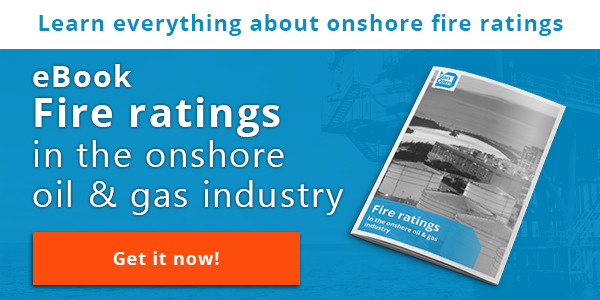
Accidental fire outbreaks in the oil & gas industry pose great risks for workers. The engineering of a safety proof structure ensures the stability of the structure and makes fire and explosion risk manageable. In this way, efficient evacuation can be realized. The ideal way to make the structure as safe as possible is by combining active fire protection and passive fire protection. Active fire protection systems are e.g. fire extinguishers or sprinkler systems. Passive fire protection is a group of systems that compartmentalize a structure through the use of fire and blast rated architectural compounds, such as fire and blast rated wall systems, doors, and windows.
Dividing or compartmentalizing an onshore oil & gas structure helps to slow or prevent the spread of fire and smoke from one compartment to another. PFP helps to limit the amount of damage done to a building and provides its occupants more time for evacuation.
Each fire and blast resistant architectural compound is designed in order to prevent the spread of fire by using materials with high fire ratings (according to project specifications). Total passive fire protection cannot be achieved through the use of one product—it requires an assembly of several different fire-resistant materials that work together systematically to slow the passage of flames, smoke, and toxic gasses. I have outlined the overall characteristics of these systems below.
Fire and blast rated walls in passive fire protection
Walls have a partitioning function within a structure and compartmentalize each area with each having its own fire rating. Compartments, where dangerous fuels and liquids are processed are most likely to have a higher fire rating than a living quarter. They are also designed to sub-divide buildings such that if a collapse occurs on one side, this will not affect the other side.
Steel is the material that ensures the strength of the structure. It is a non-combustible material and does not melt until around 1,500°C. For fire risk with a very high temperature such as hydrocarbon and jet fire, high-alloy steel is used or extra protection can be added to the steel.
Fire and blast rated doors in passive fire protection
Fire ratings for doors depend on the protection requirement of the whole compartment. When during the design phase it is decided to apply a fire rating of H120, all architectural compounds are expected to meet the same requirement.
A door allows the passage of personnel into other compartments. During a fire event, this might pose risks of fire spread due to the opening and closing function of a door. In order to protect personnel and/or equipment , door closers are applied for hinged doors and sliding doors are performed with a self-closing system.
Fire and blast rated windows in passive fire protection
Fire rated windows are an excellent option in compartments where natural light and visuals sightings are important. Their main function should always be to retain the fire rating of the area and to act as a barrier to help prevent the spread of flames and smoke in the event of a fire.
The intumescent material in fire rated windows holds the glass firmly in place and stops the glass from rattling in everyday use. During a fire, the material expands and prevents the glass from shattering.
These systems, in combination with active fire protection systems, provide the ultimate fire protection to structures in the onshore oil & gas industry. When for example active fire protection systems fail to put out the fire, passive fire protection will always be in place to contain the fire and allow for quick and safe evacuation.
Download our eBook on Fire ratings in the onshore oil & gas industry for more information.







